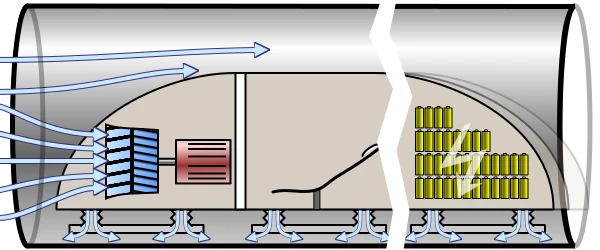Alternative News: The Hyperloop.
Any sufficiently advanced technology is indistinguishable from magic. Famed and distinguished author and scientist Sir Arthur C. Clarke has this as the third of his three laws, much like “The Three Laws of Robotics” his equally distinguished fellow writer Isaac Asimov postulated. To that end, Elon Musk is offering something that could almost be seen as magical because of the technology involved and if it comes to fruition will change the way mass public transportation is undertaken. Welcome to The Hyperloop.
In actuality, the technology is the hard part, the concept is simple. In essence, it’s a pod that will contain passengers (or cargo) that will be inside a tubular structure, with that tube largely evacuated of air and with the much talked about magnetic levitation system to propel the pod.
The basic idea has been around for some time, perhaps two hundred years, however Musk reinvigorated the idea in 2012. A concept of design was shown in 2013, paralleling the highway in California between Los Angeles and San Francisco. The distance between the two is something around 560 kilometres and the concept estimated a travel time of just over a half hour, meaning travel speeds would be in the order of over 950 kilometres per hour. Top speed would be 1200 kph, so that travel time would allow for the initial acceleration process, travel, and deceleration.
Musk first raised the idea at an event hosted by a website dedicated to technology, in Santa Monica, in July 2012. Describing it as a “fifth mode of transport”, Musk said the Hyperloop (so named because it would be a closed system in a loop) would be “a cross between Concorde, a rail gun, and an air hockey table”. He also pointed out the benefits of such a system, being it would be a 24 hour, all weather, collision free, system.
The original concept had the pod riding on a cushion of air barely 2 millimetres in depth, with each pod having an air transfer system, moving high pressure air as speed built up, to the rear. By moving to a very low pressure setup, the transfer system was deleted. A set of linear induction motors would propel the pods and because of the vastly reduced friction, the pods would be able to coast along without losing much forward velocity. The pods themselves would be around seven and a half feet in diameter, enough to comfortably have a two person side by side configuration.
Musk threw open the design rules and in 2015 his SpaceX group announced a one mile test loop close to their main facility. Several university groups have joined in, including MIT, which unveiled their concept in mid 2016. With the T in MIT standing for Technology, MIT went on to demonstrate, for the first time in the world, a working prototype in January of 2017.
As mentioned, the concept is not new. A British engineer named George Medhurst took out patents in 1799 and wrote a book in 1812 detailing propelling people and goods through air-tight tubes. The fabled Crystal Palace building in London had a railway, using fans 22 feet in diameter to move a module in a tunnel, whilst in America an underground tube system was trialled for three years in the early 1870s. Rocketeer Tobert Goddard described a system, vacuum trains, in 1910, and physicist Gerard O’Neill wrote a fictional book which incorporated trains on magnetic levitation in tunnels with almost 100% vacuum inside…
Naturally cost is a factor, including some plans for having a terminus outside of the final destination, neccessitating a further transportation method. One costing had $20USD of a one way ticket being enough to cover the costs over twenty years for the mooted SanFran-LA route. That presumed 7.4 million riders per year, however some have already questioned that that cost would be suitable. Some figures of $100 billion USD for the initial system have been mentioned, with a proportion of that cost being pylons to raise the Hyperloop above the surrounding area.
Apart from cost, the Hyperloop system does, in fact, seem feasible, with many engineering studies confirming the validity of the concept. For Australia, the eastern seaboard would be, much like the U.S., a like location, between Melbourne and Sydney, perhaps via Camberra, and from there to Brisbane with, again, perhaps a stop at Newcastle and Port Macquarie or further. Much like the much discussed Very fast Train proposal, however, it’ll need a true visionary and an economic commitment to reduce our reliance on four wheeled transport and aircraft.
Peter Bulloch says:
My question is how do you provide air in a capsule containing people which is travelling at speed in a vacuum?
March 24th, 2017 at 8:42 am
Robert Brownsitch says:
Wow. More expensive than air travel. Less flexible than air travel. Slower than airtravel. More susceptible to terrorist attack than airtravel. More susceptible to disruption by earthquakes than airtravel. This idea has the Eoin Musk stamp all over it. All it needs now are the huge taxpayer subsidises that are needed for every one of his brilliant ideas.
March 24th, 2017 at 2:20 pm